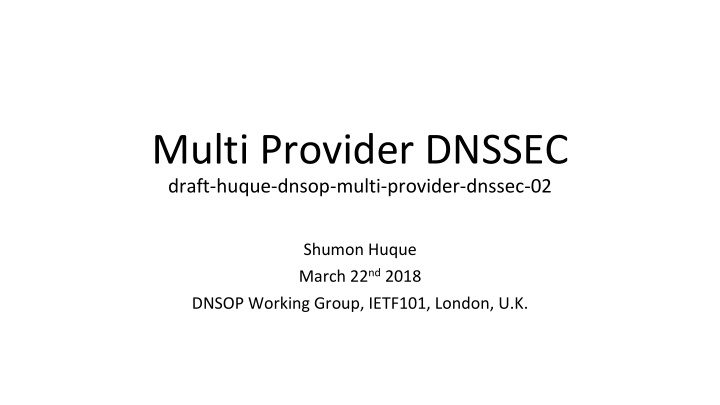



Multi Provider DNSSEC draft-huque-dnsop-multi-provider-dnssec-02 Shumon Huque March 22 nd 2018 DNSOP Working Group, IETF101, London, U.K.
Note to the DNS Camel* • This document does not propose any new extensions to the DNS protocol. • It merely outlines operational deployment models for DNSSEC with multiple providers. * https://datatracker.ietf.org/meeting/101/materials/slides-101-dnsop-sessa-the-dns-camel-01 IETF 101, March 23rd 2018, London 2
Note to the DNS Camel* • This document does not propose any new extensions to the DNS protocol. • It merely outlines operational deployment models for DNSSEC with multiple providers. * https://datatracker.ietf.org/meeting/101/mater ials/slides-101-dnsop-sessa-the-dns-camel-01 IETF 101, March 23rd 2018, London 3
Problem statement • Many organizations employ the services of multiple DNS providers to distribute their authoritative DNS service. • We want to successfully deploy DNSSEC in such an environment. • Certain types of DNS configuration/features pose challenges. IETF 101, March 23rd 2018, London 4
Deployment models • Serve Only • Sign and Serve • Inline Signing • Hybrid • Last two models are really variations/combinations of the first two, and are not ideal because they combine the weaknesses of both. IETF 101, March 23rd 2018, London 5
Serve Only • Zone owner runs master server that signs zone data. • Pushes out zone to multiple providers via DNS zone transfer. • Providers serve the zone to the world. • Zone owner holds signing keys: so managed DNS providers cannot serve false data, without detection by validating resolvers. • Well understood model. Has been deployed in the field. Works. IETF 101, March 23rd 2018, London 6
Serve Only • Zone owner runs master server that signs zone data. • Pushes out zone to multiple providers via DNS zone transfer. • Providers serve the zone to the world. • Zone owner holds signing keys: so managed DNS providers cannot serve false data, without detection by validating resolvers. • Well understood model. Has been deployed in the field. Works. • Notable limitation: doesn’t work with non-standardized DNS features that are fairly widely used in the DNS industry today. IETF 101, March 23rd 2018, London 7
Non-standard response mechanisms • Sometimes called “Traffic management”: • Global Server Load Balancing, Probe and Failover records, custom scripted responses, etc. • These types of responses are often querier-specific or dependent on inspecting dynamic state in the network • So answer and signature typically have to be determined at the authoritative server itself, at the time of the query, or both. • Also known by other colorful names : • P. Vixie, “What the DNS is not”, acmqueue, November 2009 • DNS protocol purity vs. the reality of how extensively these mechanisms are already deployed. IETF 101, March 23rd 2018, London 8
Sign and Serve • Each provider independently signs and serves zone data. • Zone owner typically uses provider specific zone management API’s to update zone content. • This model presents some novel challenges, and is essentially the primary focus of this document. IETF 101, March 23rd 2018, London 9
Sign and Serve • Can support the non-standard DNS features *if* the provider is capable of signing the response data generated by these features. • Common strategies for doing so: • On-the-fly signing • Pre-compute & sign all possible response sets, and then algorithmically determine at query time which response + signature needs to be returned. IETF 101, March 23rd 2018, London 10
Sign and Serve • Key requirement: manage the contents of the DNSKEY and DS RRsets such that validation is always possible, not matter which provider you query and obtain the response from. • Strategy: each provider has to import the zone signing (public) keys of the other providers into their DNSKEY RRset. IETF 101, March 23rd 2018, London 11
Sign and Serve models • Probably a range of possible models • We focus on a small set (currently 2) that we’ve deemed to be operationally viable and palatable, based on discussion with actual managed DNS providers. • Constraint: providers only want to directly interact with the zone owner and not with other providers (contractual reasons). • Model descriptions assume 2 providers (but generalizable to more). IETF 101, March 23rd 2018, London 12
Model 1: Common KSK, Unique ZSK per prov • Common KSK; Unique ZSK per provider. • Zone Owner holds the KSK and manages the DS record. • Each provider uses their own ZSK to sign zone data. • Zone owner uses provider APIs to extract ZSKs, assemble them into a common DNSKEY RRset, signs it, and distributes it to the providers. • Key rollovers need coordinated participation of the Zone Owner to update the DNSKEY RRset (KSK and ZSK) and DS RRset (KSK). IETF 101, March 23rd 2018, London 13
Model 2: Unique KSK & ZSK per provider • Unique KSK and ZSK per provider. • Each provider has their own KSK and ZSK. • Zone Owner uses provider API to import the ZSKs of other providers into the DNSKEY RRset. • DNSKEY RRset is independently signed by each provider’s KSK. • Zone Owner manages the DS RRset that includes both provider’s KSKs. • Key Rollovers need coordinated participation of the Zone Owner to update the DS (KSK) and DNSKEY (for ZSK). IETF 101, March 23rd 2018, London 14
Validating Resolver Behavior • Read this section to understand some of the subtleties of this configuration and why ZSK cross sharing is needed to ensure that all answers are validatable. IETF 101, March 23rd 2018, London 15
Questions/Discussion/Feedback • Is this a useful document for the DNSOP working group? • If we ask for adoption, what category should be aimed for? • Informational? BCP? Something else? • Are there other models that should be documented? • For Sign and Serve, should we recommend one specific model? IETF 101, March 23rd 2018, London 16
Recommend
More recommend